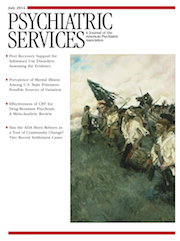Screening and Intervention for Comorbid Substance Disorders, PTSD, Depression, and Suicide: A Trauma Center Survey
Abstract
Objective
Few investigations have examined screening and intervention procedures for comorbid substance use and mental disorders at trauma centers in the United States, although these disorders are endemic among survivors of traumatic injury. In 2006, the American College of Surgeons (ACS) mandated that level I and level II trauma centers screen for alcohol use problems and that level I centers provide brief intervention for those who screen positive. The ACS is expected to recommend best practice policy guidelines for screening for drug use problems and posttraumatic stress disorder (PTSD). This study examined screening and intervention procedures for the full spectrum of comorbid mental and substance use disorders at U.S. trauma centers.
Methods
Respondents at all level I and level II trauma centers (N=518) in the United States were asked to complete a survey describing screening and intervention procedures for alcohol and drug use problems, suicidality, depression, and PTSD.
Results
There were 391 (75%) respondents. Over 80% of trauma centers routinely screened for alcohol and drug use problems. Routine screening and intervention for suicidality, depression, and PTSD were markedly less common; in fact, only 7% of centers reported routine screening for PTSD. Consistent with ACS policy, level I centers were significantly more likely than level II centers to provide alcohol intervention.
Conclusions
Alcohol screening and intervention occurred frequently at U.S. trauma centers and appeared to be responsive to ACS mandates. In the future, efforts to orchestrate clinical investigation and policy could enhance screening and intervention procedures for highly prevalent, comorbid mental disorders.



